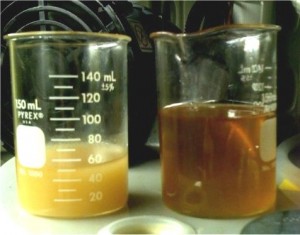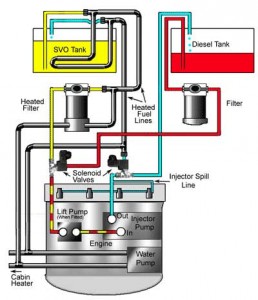Running on SVO / WVO
Straight vegetable oil refers to any vegetable oil that can power diesel engines but has not been optimized (through transesterification) for usage in automobile fuel systems under all temperature conditions. The major drawback of using SVO is that it gels at colder temperatures and must be heated prior to reaching the engine’s fuel injectors during cold weather. You can buy cooking oil and use it straight from the bottle (very expensive), or you can get it used from restaurants, which is commonly called Waste Vegetable Oil (WVO). WVO must be filtered prior to use since it contains many food particles. SVO/WVO are derived from plants such as peanuts, soy, canola/rape seed, and other grains. Both thicken at colder temperatures and can clog fuel systems unless they are heated and filtered before reaching the engine (vegetable oil can even solidify below 25 degrees Fahrenheit). Vegetable oil conversion kits include a heating system and usually a second gas tank to circumvent the cold weather issues. SVO also produces extremely low emissions.
[ad]
Twin Tank Conversion – To avoid all the electrical loading, simply divert the radiator coolant water, usually running at 85°C, through a heat exchanger around the fuel line, pump and filter. Obviously, when the engine is cold, this will be cold, so a second, small tank is installed, usually in the boot, holding diesel (dino or bio). When cold, a switch on the dashboard is activated, feeding diesel into the engine until it is up to normal operating temperature. Then the switch is moved, changing to vegetable oil which passes through the heat exchanger, injectors and into the already hot cylinders. Just before you arrive, switch back to diesel, flushing the vegetable oil out of the injectors ensuring you can start it easily next time. Starting is therefore always on normal diesel, eliminating any problems.
Single Tank Conversion – To heat up the fuel, you need to install electric heaters in the fuel line, the fuel filters and the pump. Even then, when the engine is cold, the oil will cool when entering the cylinder, so upgraded glow plugs will be needed, which operate at higher temperatures and for longer. A battery upgrade may be required to supply this extra current, and possibly also the alternator. This will enable you to pour waste vegetable oil straight into the tank and drive. If you run out of fuel, nip into the local supermarket and buy a 5 litre container of own brand vegetable oil and drive home.
Running Biodiesel – Bio-diesel is a direct replacement for derv and can be poured directly into the fuel tank. It will start and run every bit as well as dino-diesel. Most people would not even notice any difference. In fact, in France most of the diesel you buy in the petrol stations is already mixed with about 15% bio diesel. If you have filled up in France, you have already run your car partly on bio-diesel. The major car manufacturers have all adapted their cars to run on bio-diesel from around 1996 by fitting synthetic fuel lines and pump seals.
What Is Biodiesel? Straight Vegetable Oil vs Bio Diesel
For those of you still needing more information on Diesel Biofuel and running SVO should check out the video below from ParleysDiesel. This video gives a basic introduction to organic oils and how they can be run in diesel engines. Also check out their other videos, theres some great information there.


